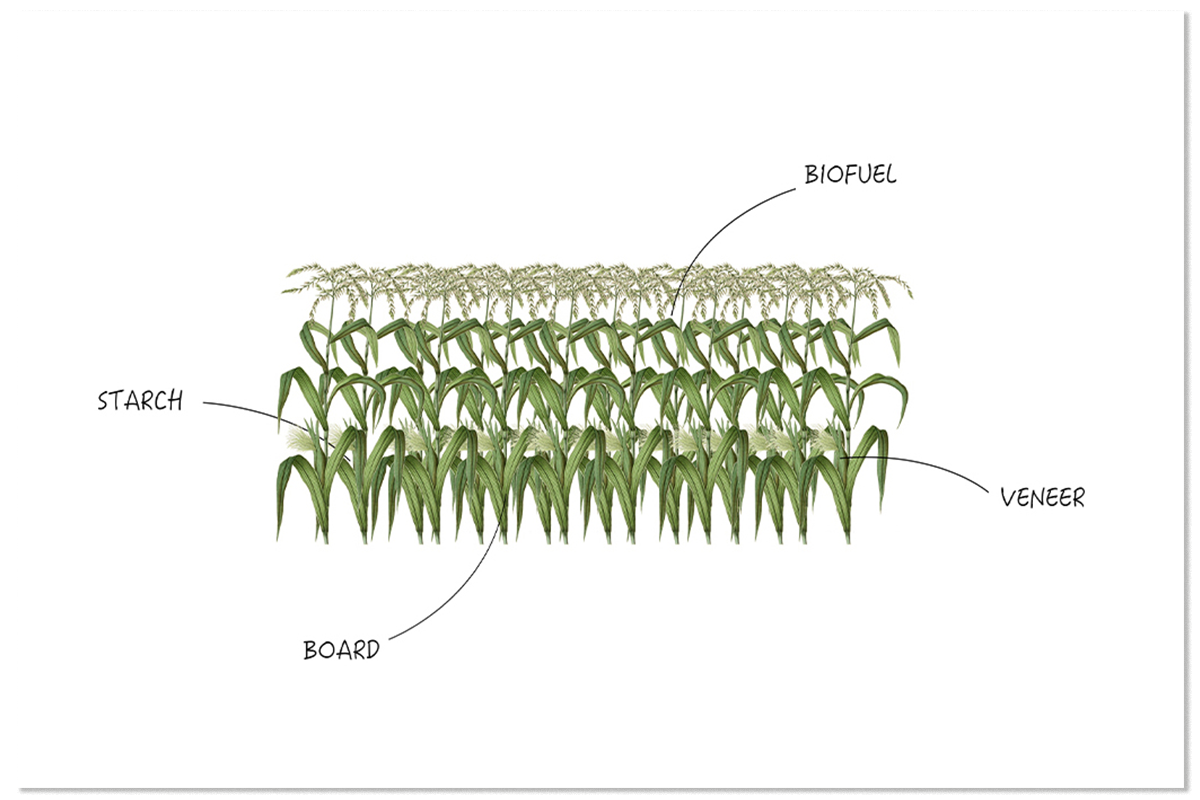May 9th, 2020
Syntropic Materials
New Design Tools for Regenerative Ecosystems
Text & visuals © Eugenia Morpurgo
This piece is the second chapter of a 4-part series written by Eugenia Morpurgo about her research project Syntropic Materials. Read the first part here
Syntropy (the antithesis of entropy) is defined as the “tendency towards energy concentration, order, organisation and life”. In agroforestry, it can refer to the “increasing” of biodiversity within a system. I encountered this concept while investigating Syntropic Farming, an agroforestry model developed by the Swiss farmer and researcher Ernst Gotsch and conceived for food production. It is “a technique of poor soils recovery by imitating existing patterns in nature in which selected species of plants are introduced in sequence and are heavily pruned during their growth period at regular intervals.” Like many other agroecological systems based on polyculture, Syntropic Farming allows producing a smaller amount of resources but of greater diversity.
My project Syntropic Materials - which I started in 2019 during a residency at the American Academy in Rome (Italy) - originated from these notions. Evaluating how a polycultural agroecosystem - rich in biodiversity - can provide a range of resources that can be used in synergy to produce innovative materials, colours, and binding agents became the core of my study. I began by archiving and mapping information on plants, the processes of transformation they can be subject to, and the elements they can produce. From well established industrial methods to more experimental ones, from traditional to innovative, the comparisons between the various methodologies became essential. I thus built a directory that would allow me to browse through this data under the logic of species coexistence.


Syntropic Materials is an attempt to combine regenerative agriculture practices with the latest development in natural material research to design regenerative production processes. Conceived as an open platform, the tool enables users to search and visualise which species grow in the same climatic zone or to filter information according to specific transformation methods or materials. If you are an agronomist, for instance, the system might help you enlarge the spectrum of species you take into consideration while designing a polycultural field for materials production. If instead, you are a designer or material engineer, it will probably foster the creation of new briefs for material design based on the combinations of plants that create regenerative ecosystems. Rather than being a simple repository of data, the platform functions as a filter and re-directory to information already published on and offline. Its primary objective is to centralise this information allowing us to create novel and meaningful connections.
What I am doing with my work is to propose a specific relationship between nature and materials production. So, naturally, one question emerges: How can I prevent that what I am proposing becomes another technocratic solution with unforeseen consequences? In this regard, one of my fundamental resolutions has been to avoid relying on the intellectual monoculture of western science. Instead, I decided to base my research on the principle of intellectual polyculture. I am interested in learning from existing discourses that attempt to solve pressing environmental problems by bringing together the wisdom of traditional indigenous environmental practices with the tools of western science. Authors such as American professor Robin Wall Kimmerer and Indian environmental activist and anti-globalisation critic Vandana Shiva have been at the forefront of this discourse for the past forty years. When reading their work, one concept resonated strongly with my questioning: The importance of relating to nature as a subject rather than as a mere object.
Read here the third part of this piece by Eugenia Morpurgo
What I am doing with my work is to propose a specific relationship between nature and materials production. So, naturally, one question emerges: How can I prevent that what I am proposing becomes another technocratic solution with unforeseen consequences? In this regard, one of my fundamental resolutions has been to avoid relying on the intellectual monoculture of western science. Instead, I decided to base my research on the principle of intellectual polyculture. I am interested in learning from existing discourses that attempt to solve pressing environmental problems by bringing together the wisdom of traditional indigenous environmental practices with the tools of western science. Authors such as American professor Robin Wall Kimmerer and Indian environmental activist and anti-globalisation critic Vandana Shiva have been at the forefront of this discourse for the past forty years. When reading their work, one concept resonated strongly with my questioning: The importance of relating to nature as a subject rather than as a mere object.
Read here the third part of this piece by Eugenia Morpurgo
Bibliography
On Syntropic Farming, https://agendagotsch.com/en/
Julia Watson, Lo-TEK Design by Radical Indigenism, Taschen, 2019
Robin Wall Kimmerer, Braiding Sweetgrass : Indigenous Wisdom, Scientific Knowledge and the Teachings of Plants, Milkweed Editions, Sep 16, 2013
About the author
Eugenia Morpurgo is an Italian designer based in Venice. Her work focuses on researching the impact that production processes have on society, with a focus on investigating and prototyping alternative scenarios and products. She works through self-initiated projects and commissioned work from companies, cultural institutions, universities and fablabs. www.eumo.it / @eugeniamorp

